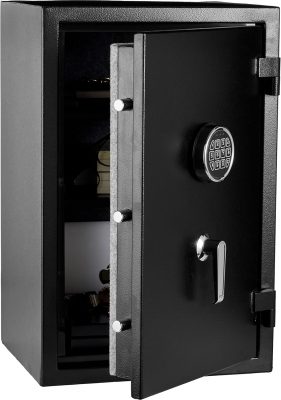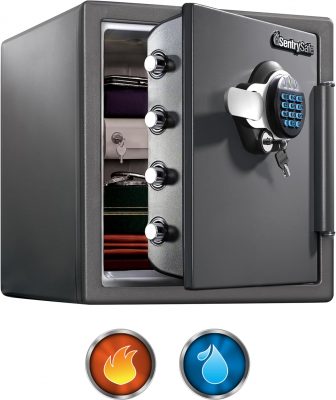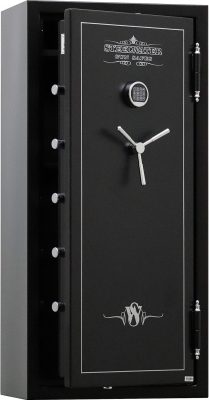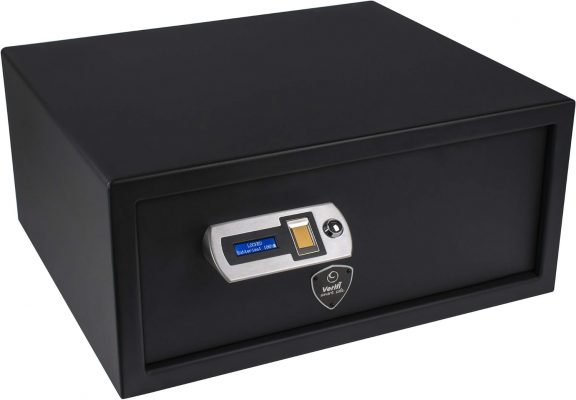How to Choose the Right Home Safe for Valuables & Documents
Why Every Home Needs a Secure Storage Solution
In today’s world, the value of security goes far beyond just locking your doors at night. With rising rates of home burglaries, the increasing frequency of natural disasters, and the growing importance of personal data, owning a secure home safe is no longer a luxury—it’s a smart, essential decision for any household.
🔐 1. Protection Against Theft
According to FBI statistics, a burglary occurs in the U.S. every 25 seconds, and most happen in broad daylight. Thieves typically spend less than 10 minutes in a home and go straight to high-value areas like bedrooms. A properly installed safe not only protects valuables from theft but also discourages criminals who are short on time.
Items to Secure from Theft:
Jewelry and cash
Firearms
Personal identification documents
Luxury watches or collectibles
🔥 2. Fire and Disaster Preparedness
House fires and natural disasters such as floods or hurricanes can happen without warning. Safes that are fireproof and waterproof provide an extra layer of protection when disaster strikes—often buying you crucial time to recover after a loss.
Documents You Don’t Want to Lose:
Birth certificates, passports
Wills and powers of attorney
Insurance policies
Property deeds and titles
🛡️ 3. Privacy and Controlled Access
Whether you live alone, with roommates, or have children, certain items—like prescription medications, legal papers, or firearms—should be kept in a secure, restricted location. A safe allows you to control who can access sensitive or dangerous items.
Everyday Items Worth Locking Away:
Medication or medical cannabis
Sensitive tax documents or financial records
Family heirlooms
Backup drives or photo storage
💾 4. Digital Data Protection
We live in a digital age, and yet many forget that physical protection for data is just as important. Flash drives, backup hard drives, and even laptops can be destroyed in a fire or flood. A home safe designed for media storage can safeguard years’ worth of family photos, work files, and personal data.
Why It Matters: Insurance can replace a TV—but no policy can replace lost memories or tax records.
🧘♀️ 5. Peace of Mind
Ultimately, a home safe provides more than just physical security—it offers mental security. Knowing your most important documents, valuables, and memories are protected can reduce stress, simplify emergency planning, and help you sleep better at night.
Whether you’re a homeowner, renter, parent, or frequent traveler, a home safe provides a reliable way to safeguard what matters most. It’s a small investment that delivers huge returns in peace of mind, security, and preparedness.
Types of Safes: Fireproof, Waterproof, Biometric, Keypad
With so many home safe options on the market, it’s easy to get overwhelmed. But understanding the different types of safes—and what they’re designed to protect against—is the first step to making the right purchase.
Below, we break down the four most common types of safes, with detailed insights into their functionality, ideal use cases, and what to consider when choosing one.
🔥 Fireproof Safes
Purpose: Protects against heat and flames during house fires.
A fireproof safe is a must-have if you’re storing documents like birth certificates, legal records, cash, or irreplaceable keepsakes. These safes are built with fire-resistant insulation that delays internal heating even as external temperatures soar.
Key Specs to Know:
UL Rating (Class 350): Keeps paper below 350°F for a specific time.
UL Rating (Class 125): Keeps electronics and digital media under 125°F.
Time Protection: Choose between 30 min, 60 min, 90 min, or 120+ min protection.
What to Store:
Passports, Social Security cards
Marriage licenses, deeds, wills
Cash reserves
External hard drives or backup devices (if media rated)
Most house fires burn between 1,100°F and 1,800°F. Opt for a UL or ETL verified safe that can handle these temps for at least 1 hour to truly protect your items.
💧 Waterproof Safes
Purpose: Shields against floodwater, burst pipes, and water from firefighting.
Even if you’re not in a flood zone, a waterproof safe can save your valuables during emergencies like hurricanes, broken plumbing, or sprinkler system accidents. Many fireproof safes come with built-in water protection, but it’s important to confirm the ETL or IPX rating.
What to Look For:
Submersion Proof: Safe remains sealed under water (e.g., 8 inches for 24 hours).
Spray Resistance: Withstands hose pressure during firefighting.
Gasket Seals & Design: Look for solid steel or composite builds with rubberized seals.
Ideal for Storing:
Insurance papers, emergency contact lists
Family photos and albums
Flash drives, memory cards
Precious metals or coin collections
Expert Tip:
Avoid placing your waterproof safe directly on the ground. Use a shelf, pedestal, or elevated location to further protect from deep flooding.
🔐 Biometric Safes
Purpose: Provides quick access via fingerprint scanning.
Biometric safes are perfect for those who need fast, reliable access to their valuables—like firearm owners or those with medications requiring tight control. These safes use fingerprint technology to unlock instantly and often allow storage of multiple prints (e.g., for spouses or other family members).
Key Features to Compare:
Sensor Quality: FBI-certified sensors offer superior speed and accuracy.
User Capacity: Check how many fingerprints can be stored.
Access Logs: Premium models log entries and attempted accesses.
Power Backup: Battery life, USB charging, or emergency key override.
What to Store:
Handguns and self-defense items
Prescription medications
Jewelry or high-value collectibles
Emergency cash
Biometric safes are ideal for nightstands or bedside drawers, offering both convenience and safety. Always choose a model with manual override or backup keys in case of power failure.
🔢 Keypad Safes (Digital & Mechanical)
Purpose: Access through numeric codes or combination dials.
Keypad safes are the most common and affordable type, balancing security with ease of access. Whether digital or manual, they let you set your own code—and many offer lockout features if incorrect codes are entered too many times.
Digital Keypads:
Battery-powered, often backlit for night use
Easy to program and reprogram codes
Often includes auto-lockout after failed attempts
Manual Dials:
No electronics—great for those avoiding battery maintenance
Harder to reset but extremely reliable
Often used in vintage or ultra-secure safes
Dual-Lock Models:
Many high-end safes feature a keypad + key or keypad + biometric combo for layered security.
Best For:
General home use (documents, cash, jewelry)
Shared access in households or offices
People who prefer PINs over biometric access
Choose a keypad model with at least 2 user PINs if you plan to share access. Also, replace batteries annually—even if not prompted—to avoid being locked out unexpectedly.
Choosing What’s Best for You
| Type | Strengths | Limitations | Ideal For |
|---|---|---|---|
| Fireproof | High heat resistance, certified by UL/ETL | May not resist water unless specified | Legal documents, cash, hard drives |
| Waterproof | Submersion and spray protection | Often heavier, may cost more | Flood-prone areas, insurance papers |
| Biometric | Fast fingerprint access, high security | Power/battery dependent, pricier | Firearms, medications, fast access |
| Keypad | Easy to use, customizable, affordable | Requires remembering codes or batteries | Daily use, shared access, budget users |
Hybrid Safes
Many modern safes combine two or more types for multi-threat protection. For example, a safe may be both fireproof and waterproof, with a biometric lock and keypad backup. These offer the best of all worlds, especially for those who want to secure a variety of items in one place.
Look For:
UL + ETL dual certifications
Multi-lock options (biometric + keypad + key)
Heavy-duty construction with bolt-down kits
When choosing a safe, don’t just think about what you want to protect—think about what you want to protect it from. Fire? Theft? Water? Quick access? There’s a specific type (or combo) that fits your lifestyle and needs.
What Size Do You Really Need?
When it comes to choosing a home safe, size is more than just a matter of space—it’s a matter of security, accessibility, and long-term usefulness. Many people make the mistake of buying a safe that’s too small, only to realize later they need more room. On the other hand, an oversized safe can be bulky, expensive, and harder to conceal.
So how do you determine the right size for your needs? Here’s what to consider:
📦 Start With What You’ll Store
Take inventory of the items you plan to protect. Different items require different internal space and layout configurations. Ask yourself:
Documents: Will you need to store folders, binders, or legal-size papers flat?
Valuables: Are you storing bulky items like cameras, heirlooms, or firearms?
Digital Media: Do you need space for hard drives, USBs, or laptops?
Emergency Supplies: Are you including emergency cash, spare keys, or medication?
📏 Understanding Safe Capacities (Measured in Cubic Feet)
Most safes are measured in cubic feet (cu. ft.) or liters in international markets. Here’s a general guide to help you choose the right size:
✅ Small Safes (0.3 – 0.8 cu. ft.)
Ideal For:
- Passports, IDs, small stacks of cash
- Jewelry, watches, prescription meds
- A few flash drives or backup CDs
Use Case:
Perfect for apartments, nightstands, or renters who need portable protection. Often compact enough to be tucked into drawers or mounted to shelves.
✅ Medium Safes (0.9 – 1.8 cu. ft.)
Ideal For:
- Folders, standard-size documents, small electronics
- External hard drives, tablets
- Family heirlooms or valuables that don’t take up much space
Use Case:
Great for families or homeowners with modest storage needs. These safes typically offer both security and ease of access for regular use.
✅ Large Safes (2.0 – 3.5 cu. ft.)
Ideal For:
- Legal-size documents, large binders
- Laptops, cameras, firearms
- Combining both documents and valuables in one safe
Use Case:
Best for long-term storage and protection of multiple item types. These often weigh over 100 lbs and are typically floor-mounted for added security.
✅ Extra-Large Safes (4.0+ cu. ft.)
Ideal For:
- Full household archives, business records
- Collectibles, gold/silver bars, or extensive jewelry collections
- Multiple electronics or large emergency kits
Use Case:
Designed for high-security storage in dedicated rooms or home offices. Often used in businesses, high-value homes, or for firearm collections.
Your security needs may grow over time. It’s wise to choose a safe with 10–20% more space than your current inventory. You’ll thank yourself later when you find new items that need protection.
A half-full safe is better than an overflowing one. Overstuffing can lead to disorganization, difficulty retrieving items, and even damage.
Consider Your Living Space
Where you live can also influence the best size:
Apartment or condo: Small to medium safes with easy concealment (like in closets or under beds).
Single-family home: More options for large, floor-mounted safes in closets, garages, or basements.
Tiny homes or RVs: Look for fireproof lockboxes or mini safes that maximize space and mobility.
Also consider weight and mobility:
Heavier safes are harder to steal but harder to move.
Lighter safes are more convenient, but they must be anchored or hidden to prevent easy theft.
Internal Organization Matters Too
It’s not just about cubic feet. Look for interior features that improve usability:
Adjustable shelves to accommodate both documents and larger items
Locking drawers or compartments for added security within the safe
Padded lining to protect jewelry or fragile items
Interior lighting for visibility in low-light areas
Quick Size Reference Chart
| Safe Size | Capacity | Best For |
|---|---|---|
| Small | 0.3 – 0.8 cu. ft. | Jewelry, cash, passports, small media |
| Medium | 0.9 – 1.8 cu. ft. | Documents, folders, compact electronics |
| Large | 2.0 – 3.5 cu. ft. | Laptops, firearms, heirlooms, emergency supplies |
| Extra-Large | 4.0+ cu. ft. | Full household storage, large valuables |
Choosing the right safe size isn’t just about what fits—it’s about what works for your lifestyle, storage habits, and future plans. Start by identifying what you want to protect, then match that with a size that fits both your inventory and your living space.
If you’re on the fence between two sizes, go with the larger one. A bit of extra space today can save you the hassle of replacing your safe later on.
Top Home Safes for Every Budget & Use Case
Choosing the right home safe means balancing security, storage capacity, and features that align with your lifestyle. Below are some of the most reliable and well-reviewed home safes on the market, grouped by general use cases—ranging from compact storage solutions to high-security fireproof units.
Each of these safes has been selected for its durability, safety features, usability, and trusted performance, making them excellent choices for securing everything from documents and jewelry to firearms and digital media.
Compact and straightforward, this safe offers a solid entry point for homeowners looking to secure essential documents and valuables without complicating things. It features fire resistance for short-term protection, a programmable digital lock, and a simple design that fits easily into closets or under desks.
Its steel construction and pry-resistant door provide a decent level of security, while the adjustable shelf adds flexibility for organizing items like passports, jewelry, USB drives, and small amounts of cash. While it’s not designed to withstand extended fires or water exposure, it offers peace of mind for everyday valuables that need a dedicated, private place.
A great match for renters, students, or first-time safe owners who want affordable, basic fire protection in a convenient, easy-to-use format.
This model offers well-rounded protection against two of the most common household threats: fire and water damage. UL classified to withstand temperatures up to 1700°F for one hour and verified for 24-hour water resistance, it’s ideal for securing irreplaceable paperwork, backup drives, family heirlooms, and emergency supplies.
Its illuminated digital keypad makes access quick and intuitive, even in the dark, while the internal LED light and adjustable shelf help keep contents visible and organized. A locking drawer adds an extra layer of separation inside the safe, useful for storing small valuables discretely.
The safe’s weight and bolt-down hardware also provide resistance to theft, making it a strong choice for homeowners seeking a balance between daily usability and disaster readiness.
Built like a tank, this heavy-duty safe is designed for those with more serious security concerns—whether that’s business records, large jewelry collections, or a combination of high-value items. It offers exceptional fire resistance, rated to protect contents for up to two hours at temperatures reaching 1850°F.
Its reinforced steel body, multi-point locking bolts, and drill-resistant design make it difficult for intruders to break into, while the EMP-proof electronic keypad ensures the lock remains functional even after an electromagnetic pulse or power surge. Inside, adjustable shelving provides room for everything from documents and collectibles to firearms and external drives.
With its substantial weight and serious fire rating, this safe is ideal for permanent placement in a home office or dedicated storage room, especially for those who want long-term, high-level protection with minimal compromise.
For those who prioritize quick access without compromising security, this biometric safe offers high-speed fingerprint unlocking powered by an FBI-certified sensor. Capable of storing up to 40 fingerprints, it’s a practical solution for families or individuals who need controlled but immediate access to the contents inside.
It includes helpful features like interior lighting, adjustable shelving, and tamper alerts—plus it automatically locks the moment the door is closed. The audit trail feature logs entries and failed access attempts, which adds an extra layer of awareness and accountability.
While it isn’t rated for fire or water resistance, it excels in speed, technology, and user management. This makes it especially well-suited for firearm storage, daily-use items, or securing medications in households with children or guests.
Combine Multiple Safes for Greater Security
Rather than relying on a single safe, many homeowners choose to use more than one for different purposes. For example:
A biometric safe in the bedroom for quick access to personal protection
A fireproof unit in the closet for important legal and financial documents
A hidden lockbox for discreetly storing spare keys or emergency funds
Spreading out your valuables in multiple locations can also reduce risk during a break-in, as burglars have limited time and are unlikely to search beyond the most obvious places.
Safe Placement Tips for Maximum Security
Even the most secure safe can be compromised if it’s placed in the wrong spot. Where you install your safe is just as important as the safe itself. Thieves, fires, and floods all have patterns—and understanding these patterns helps you outsmart them.
Here’s how to choose a safe location that maximizes protection while minimizing risk.
🎯 Understand How Burglars Think
Most burglaries are quick and opportunistic. Intruders typically spend under 10 minutes in a home and head straight for the master bedroom, home office, and living room—areas where people commonly store valuables.
Takeaway: Avoid obvious places like closets in the primary bedroom or under the bed. These are the first spots criminals check.
📍 Recommended Safe Locations
1. Inside a Closet (But Not in the Bedroom)
- A closet in a guest room, hallway, or utility area is less obvious.
- Anchor the safe to the floor or back wall.
- Surround with clothing or boxes to blend in.
2. Basement or Utility Room
- Offers discreet placement away from high-traffic areas.
- Be cautious about moisture—only place safes in dry, climate-controlled sections.
- Avoid storing in flood-prone zones unless the safe is waterproof.
3. Inside a Built-In Cabinet or Bookshelf
- Concealing a safe behind books or within cabinetry adds a layer of visual protection.
- Wall safes or small units can be hidden behind a false back panel or a framed picture.
4. Behind Large Furniture
- Place the safe behind a heavy dresser, entertainment center, or filing cabinet.
- Make sure it’s still accessible for regular use but not immediately visible to guests or intruders.
5. Under Floorboards or in a Trap Door Compartment
- This approach requires more setup but offers excellent concealment.
- Ideal for small fireproof lockboxes or hidden safes storing emergency cash or sensitive items.
6. Inside the Garage (with Caution)
- Only recommended if the garage is climate-controlled and well-secured.
- Avoid placing safes in plain sight near windows or entrance doors.
- Use a heavy-duty safe and ensure it’s bolted to concrete.
🔐 Bolting Down Your Safe: A Must for Security
A lightweight or unanchored safe can be picked up and carried out in minutes. No matter where you place your safe, anchoring it is one of the most important security steps.
Anchoring Tips:
- Use included bolt-down kits and secure the safe to concrete or hardwood, not drywall or carpet.
- For wall safes, make sure you’re drilling into wall studs, not just hollow sections.
- Always follow manufacturer guidelines to preserve the safe’s fire/water resistance and warranty.
🌊 Consider Environmental Risks
1. Fire Safety
- Place the safe away from heat sources (stoves, furnaces, fireplaces).
- Install it at lower levels of the home—fire travels upward, and lower placement often offers more protection.
2. Flood Protection
- Never place a non-waterproof safe directly on the floor in flood-prone basements.
- Use a shelf, riser, or concrete platform to elevate the safe several inches off the ground.
- Consider combining with a waterproof/fireproof bag for double-layer protection.
3. Humidity & Mold Prevention
- In humid environments, moisture can damage paper and corrode metal inside the safe.
- Use desiccants or dehumidifier packs inside the safe to prevent mold and rust.
- Choose safes with sealed interiors and consider models with anti-moisture linings.
Your safe should be hidden from plain view but still accessible enough that you’ll actually use it. If it’s too difficult to reach, you may end up storing items elsewhere, defeating the purpose of having it.
Smart Concealment Ideas:
- Behind a hinged mirror or artwork
- Inside a faux electrical panel
- Inside an unused appliance or disguised box
- Beneath removable floor tiles or trap doors
🏡 Placement by Home Type
Apartments/Condos:
- Look for smaller safes that can fit in closets, under beds, or inside cabinets.
- Use portable fireproof lockboxes if permanent anchoring isn’t allowed.
- Consider dual-lock safes with biometric access if sharing the unit with others.
Single-Family Homes:
- More flexibility for larger, floor-mounted or wall-mounted safes.
- Ideal for long-term protection, firearms, and family archives.
- Choose a central location if you plan to access the safe frequently.
Vacation or Rental Homes:
- Install safes in hard-to-spot areas with backup access.
- Choose safes with digital locks to avoid managing physical keys.
- Bolt down to prevent removal while the property is unoccupied.
A quality safe is only as secure as the location you choose. By installing it in a low-visibility, anchored, environmentally-safe spot, you significantly reduce the risk of theft or damage. Think like an intruder—but plan like a protector.
Before installing, take a few minutes to walk through your home and evaluate places you wouldn’t think to look for valuables. That’s often the perfect spot.
Conclusion: Invest in Peace of Mind
Whether you’re securing your family’s most important documents, protecting irreplaceable heirlooms, or simply ensuring quick access to emergency essentials, a reliable home safe offers something far greater than just physical protection—it provides peace of mind.
As we’ve explored, the best home safes in 2025 come in many forms: fireproof models to withstand house fires, waterproof units to defend against floods, biometric safes for fast and controlled access, and keypad versions for everyday convenience. Choosing the right one depends on your personal needs, the types of valuables you’re protecting, and the potential threats in your environment.
Remember:
- Understand your storage needs before deciding on a size.
- Prioritize dual protection (fire and water) for documents and electronics.
- Think beyond price—consider long-term value and resilience.
- Anchor and conceal your safe strategically for maximum security.
There’s no one-size-fits-all solution, but there is a right safe for every household—and making that investment now can save you tremendous stress, time, and money later.
Start by listing what you need to protect and where you plan to install your safe. From there, explore the models that match your priorities and environment. Need help narrowing down the options? Drop your questions in the comments or get in touch for personalized recommendations.




